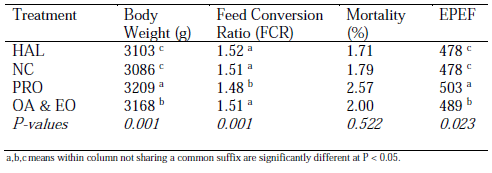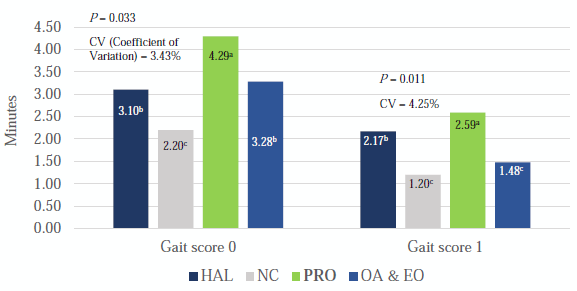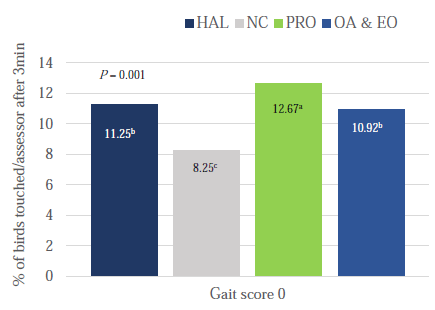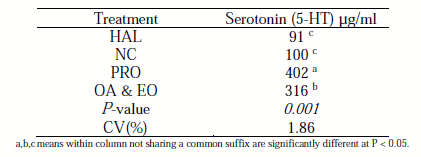I. INTRODUCTION
To ensure productivity of poultry farming, the intestinal health of chickens, among other factors, must be considered to achieve maximum nutrient absorption and utilisation for the animals to develop properly (Oleforuh-Okoleh et al., 2015). Nonetheless, with the reduction or ban of the use of performance-enhancing antimicrobials on a worldwide basis, the quest for products able to modulate the intestinal microbiota of birds has intensified. Enzymes, organic acids, prebiotics, symbiotics and probiotics stand out among additives that enhance performance by acting on the intestinal microbiota (Bozkurt et al., 2014). In poultry farming, Lactobacillus, Bacillus, Bifidobacterium and Enterococcus bacteria are commonly used as probiotics to support intestinal health and performance (Zaghari, et al., 2015). An ever-present concern under these intensive conditions is the behaviour and welfare of birds. In human health, the study of the microbiota-gut-brain axis has advanced greatly in recent years as investigators seek to understand the interaction of probiotic strains and cognitive functions (Bested et al., 2013; Carabotti et al., 2015). Therefore, for poultry production, evaluations of probiotics have been investigated to determine potential beneficial impact for both performance indexes and broiler welfare. Welfare parameters such as LTL, approximation test and serotonin plasma concentrations were described to be relevant bird behaviour and well-being indicators (Almeida et al., 2019). Serotonin (5-hydroxytryptamine; 5-HT) is a known neurotransmitter critical for the development function of the central nervous system and a good indicator of well-being status (Ezenwa et al., 2012).
II. MATERIAL AND METHODS
1600 male broilers (Aviagen AP95) were randomly assigned to one of four treatment groups (50 birds per replicate, 8 reps). Four treatments were applied, HAL (Halquinol at 75mg/kg feed), NC (negative control group with no AGP, no probiotic, no blend of essential oils or organic acids, PRO (mix of probiotic strains at 500g/T feed), consisting of B. subtilis (DSM 32325), B. subtilis (DSM 32324) and B. amyloliquefaciens (DSM 25840), and OA&EO (blend of benzoic acid and thymol, eugenol, piperine at 300 g/T feed). The same nutritional profile was used for the dietary treatments during the different feeding phases. Broilers were fed from age day 0 to 42. Feed intake, body weight, feed conversion ratio and mortality (%), were collected on a weekly basis. At 42 days of age the birds were submitted to 2 well-being tests using an LTL test and approximation test. For the LTL test, a plastic container measuring 75 × 50 × 20 cm was filled with 3 cm of water at room temperature, where 6 chickens were placed at a time. A digital stopwatch recorded the time the birds took until the first attempt to lie down. The test was interrupted if the bird was still standing after 370 s. For the approximation test, an assessor entered the pen and, after 3 min, extended his or her arms and counted how many animals could be touched. At 42 days of age, gait scoring was measured using a three-category system (0: No obvious signs, 1: Obvious signs, 2: Severe signs). Plasma concentrations of serotonin were measured at 40 days of age using a Serotonin/hydroxytryptamine 5-HT Elisa kit. Samples were collected from 8% of broilers in each treatment. Data were analysed using SAS 9.2 program, using ANOVA and Tukey's test (p < 0.05) for parametric data and Chi-Square or Fisher's exact test (p < 0.05) for nonparametric data.
III. RESULTS AND DISCUSSION
As presented in Table 1, daily feeding of PRO and OA&EO resulted in significant improvements in final body weight and EPEF corrected for mortality (P< 0.05) compared to the NC and HAL groups. FCR was significantly lower in birds fed the PRO treatment compared to those fed any other treatment. Treatment had no significant impact on mortality rate (%). Latency to lie for both gait scores 0 and 1, representing 90% of the birds, is shown in Figure 1. The group fed PRO demonstrated a significantly longer standing time in the LTL test compared to those fed NC, HAL and OA&EO, suggesting these birds had a better resilience to stress and better leg health status.
Table 1 - Body Weight (g), FCR, Mortality (%) and EPEF results by treatment group at 42 days of age.
Figure 1 - Results for latency to lie (LTL) test (in minutes and seconds) by treatment group for broilers with Gait 0 and 1 scores.
Figure 2 shows that, in the approximation test evaluation performed on birds with Gait 0 score, after 3 min in pens, the % of birds touched by the assessor was significantly higher for broilers fed with PRO than for the groups fed with HAL, NC and OA&EO treatments which exhibited lower % of birds touched by the assessor.
Figure 2 - Results of approximation test results expressed in % of birds touched by the assessor after 3 minutes in a pen (for broilers with score Gait 0) per treatment group.
In parallel to the LTL and approximation tests, plasma serotonin levels measured at 40 days of age and results are presented in Table 2. Birds receiving the mix of triple strains probiotic (PRO) exhibited a significantly higher level of plasma serotonin (P = 0.001) in comparison to HAL, NC and OA&EO treatments.
Table 2 - Measurements of plasma serotonin (5-HT) levels in broilers per treatment group at 40 days of age.
In conclusion, the birds fed daily with treatment PRO had better feed conversion, better growth and consequently, better production efficiency factor as compared with birds receiving treatments HAL, NC and OA&EO. Concurrently, the birds’ well-being significantly improved when the PRO diet was provided. Significantly improved scores in the LTL and approximation tests indicates that those birds tended to be more calm and resilient to stress. Significantly higher levels of plasma serotonin (μg/ml) at 40 days of age for broilers fed the PRO treatment, support the positive impact of the PRO treatment on performance and well-being parameters of broilers.
Presented at the 34th Annual Australian Poultry Science Symposium 2023. For information on the next edition, click here. 













.jpg&w=3840&q=75)